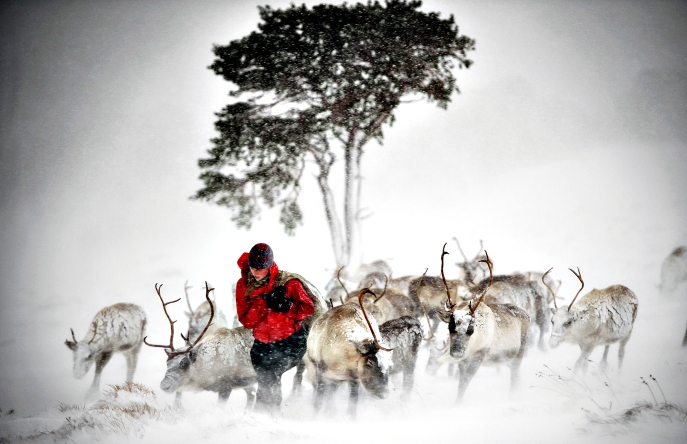Reindeer are the only semi-domesticated animal which naturally belongs to the north. Reindeer herding is conducted in 9 countries; Norway, Finland, Sweden, Russia, Greenland, Alaska, Mongolia, China and Canada. Most importantly of course our small herd here in the Cairngorms!

There are roughly 30 different reindeer herding cultures (i.e. the Sami in Scandinavia) with up to four million reindeer! (A few more than our 150!). There is often an intimate relationship between herders and their reindeer as well as husbandry, which, wherever practiced is often almost identical.
Reindeer represent one of the only domesticated species with which humans still live to their terms and needs instead of making the reindeer adapt to ours. For example, popping a reindeer in a grassy field prevents them grazing and migrating normally, which is key to a healthy and happy (reindeer) life. Reindeer herding is socially and culturally extremely important as each ‘group’ of herding peoples have unique identities and cultures centring on their way of life with their reindeer. Economically reindeer are also very important as meat and other products make up these cultures’ livelihoods.

In the modern reindeer vernacular you’ll find two terms, ‘reindeer herding’ and ‘reindeer husbandry’ – herding is the much older concept which mainly refers to working with the reindeer whereas the ‘husbandry’ encompasses not only the reindeer but the entire herding industry: socio-economic issues, scientific research and management. As with many traditional occupations around the world the reindeer herding lifestyle is under threat from loss of pasture land, predators and of course climate change, which has an immediate effect on grazing.
As you may know, the Cairngorm herd are a family owned business and this is often true of reindeer herders across the globe where individual owners often work in co-operation with their families, neighbours or villages to care for their reindeer. There are around 100,000 reindeer herders in the circumpolar north today which is a lot more than our 7 full-time members of staff! Reindeer herding varies between different cultures and countries but the one thing which remains constant is the need for herds to migrate between summer and winter pastures. If you’ve visited us here in the summer you’ll know that at this time of year our female reindeer are up and away on the Cairngorm plateau where they find yummy alpine plants and relief from insects; they then return to lower more stable winter pastures where they find their favourite food: lichen.

Reindeer herding is not a 9-5 job but a way of life: here in the Cairngorms, our daily routine is dependent on where the reindeer are, the weather conditions, pasture land and the seasons. In fact, for the Sámi, their yearly calendar is entirely based upon what reindeer are doing during specific seasons. For example, early spring is known as Gijrra – The Season of Returning – winter is ending, snow is melting and the reindeer return to familiar calving grounds for May or Miessemannu – the calf month.

The lovely thing about reindeer herding is by working with these wonderful (sometimes ridiculous) creatures your work is not only focused by your own goals but it is truly dependent on the reindeer themselves and most importantly the natural world around you.
Abby
